Unit – 2
Introduction to Internal Combustion (IC) Engine
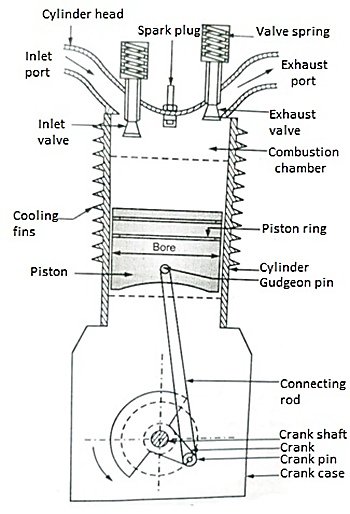
Fig. IC Engine
Components of IC Engine
Materials used are cast iron or alloy steel.
Cylinder is provided with a cylinder lines on the inner side and a cooling arrangement on outside.
2. Piston: The function of piston is to transmit the gas force to connecting rod and hence to the crank. It slides in the cylinder.
It is made up of cast steel or aluminium steel.
3. Piston ring: Two or more piston rings made up of cast steel are provided.
They seal the space between the cylinder lines and piston, to preventleakage of high-pressure gases from cylinder to crank case.
4. Crank Shaft: It runs under the action of piston through the connecting rod and crank pin and transmits the power from piston to drive shaft.
It is made up of medium carbon steel.
5. Crank: Crank is an integral part of the crank shaft. It is a rotating member and makes circular motion in the crank case.
It’s one end is connected to crank shaft and another end is connected with a connecting rod.
6. Connecting rod: It is a link between the piston and crank. It transmits the reciprocating motion of piston to the continuously rotating crank pin during working stroke and vice versa during other strokes.
It is made up of carbon steel.
7. Exhaust Manifold: Exhaust manifold is system of pipe, which connects the exhaust port of various cylinders to a common exhaust system for the engine.
8. Inlet Port: Through inlet port, the charge is sucked into the cylinders.
9. Exhaust Port: Through exhaust port, the exhaust gases from the cylinder are expelled out to the atmosphere.
10. Gudgeon pin/ Piston Pin: It is made up of hardened steel in the shape of spindle. It connects the piston to the smaller end of the connecting rod.
11. Governor: It is run by a drive from crank shaft. Its function is too regular the quantity of charge to maintain the engine speed constant, even though there is variation in load on engine.
12. Water Cooled Jacket: The cylinder is surrounded by means of water-cooled jacket, to dissipate the heat evolved during combustion.
13. Flywheel: It is a wheel mounted on the crank shaft, which stores excess energy produced during power stoke. This excess energy is given back by flywheel, which is utilises in running the idle strokes (Power consuming) such as suction, compression and exhaust.
14. Spark Plug: Its function is to ignite the mixture after completing the compression stroke in petrol engine.
It is generally mounted in the cylinder head. Spark Plug is used in case of petrol engine.
15. Fuel pump: It force the fuel at high pressure through fuel nozzle into the cylinder at the end of compression stroke diesel engines
16. Fuel Nozzle: The function of fuel nozzle is to break up the oil into the fine spray, when it enters the cylinder of diesel engines.
17. Carburettor: It is provided in the petrol engines for preparation of a homogeneous mixture of air and fuel (petrol).
Four stroke cycle Petrol Engines
Construction:
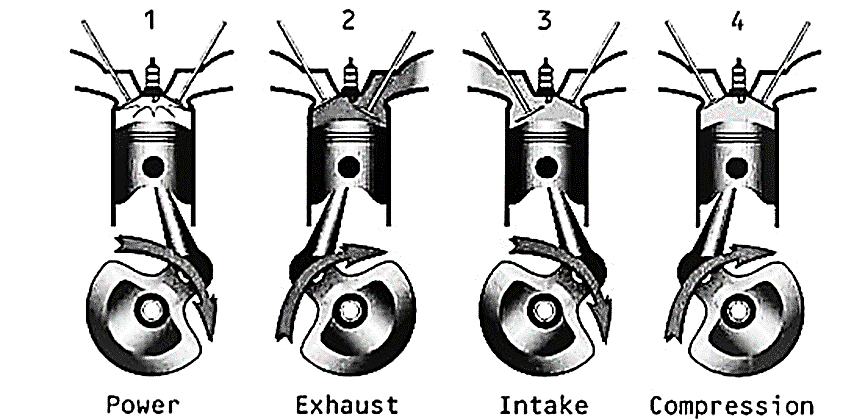
Piston moves up from BDC to TDC • Both inlet and exhaust valves are closed. • The air fuel mixture in the cylinder is compressed.
The burning gases expand rapidly. They exert an impulse (thrust or force) on the piston. The piston is pushed from TDC to BDC • This movement of the piston is converted into rotary motion of the crankshaft through connecting rod. • Both inlet and exhaust valves are closed.
Piston moves upward from BDC • Exhaust valve is opened and the inlet valve is closed. • The burnt gases are forced out to the atmosphere through the exhaust valve (Some of the burnt gases stay in the clearance volume of the cylinder) • The exhaust valve closes shortly after TDC • The inlet valve opens slightly before TDC and the cylinder is ready to receive fresh charge to start a new cycle.
2. Stroke: Stroke is defined as the distance travelled by piston from one dead crank to another dead centre.
3. Top Dead Centre:
In case of vertical engine, the topmost position of piston towards cover end side of cylinder is called as top dead centre. In case of horizontal engines. It is known as inner dead centre.
4. Bottom Dead Centre:
In case of vertical engines, the lowest position of piston towards the crank end side of cylinder is called as bottom dead centre. In case of horizontal engine, it is known as outer dead centre.
5. Clearance Volume:
Clearance Volume is defined as the volume contained in the cylinder above the top of piston, where the piston is at TDC.
It is denoted by Vc.
6. Swept Volume:
Swept volume is defined as the volume swept by position when it moves from TDC to BDC or BDC to TDC
Swept volume is also called as stroke volume or displacement volume. It is denoted Vs.
Mathematically
 =
=  .
.  . L
. L
where, D= Bose Or Diameter of cylinder in ‘m’
L= Length of Stroke in ‘m’
7. Total Volume:
Total Volume is defined as “the volume contained in the cylinder above the top of piston, when the piston is at BDC”
Total volume is the algebraic sum of swept volume and clearance volume. It is denoted by V.
V=Vs + Vc
8. Compression Ratio:
Compression ratio is defined as “the ratio of total cylinder volume to clearance volume.
r =  =
= 
9. Cut of Ratio:
Cut of ratio is defined as “the ratio of volume inside the cylinder at the end of heat supplied to the volume of before heat supplied.
10. Piston Speed:
Piston Speed is defined as “The distance travelled by Piston in one minute.
Piston Speed = 2 x L x N
L = Length of Stroke in ‘m’
N = Engine Speed in ‘m’
I.C. Engines may be classified as.
1. According to cycle of operations
a) Two stroke cycle engines, b) From stroke cycle engines
2. According to cycle of combustion
a) Off Cycle b) Diesel cycle c) Dual cycle
3. According to arrangement of cylinder
a) Horizontal engine b) Vertical Engine c) V-type engine
d) Radial engine
4. According to type of fuel used
a) Oil engine b) Petrol engine c) Gas engine d) Kerosene engine e) Diesel Engine
5. According to speed (r.p.m) of engine
a) Low speed b) Medium speed c) High speed
6. According to method of ignition
a) Spark ignition (S. I Engine) b) Compression ignition (C.I Engine)
7. According to method of cooling the engine cylinder.
a) Air cooled engine b) Water cooled engine
8. According to method of governing
a) His and miss governing b) Quality governing
c) Quantity governing
9. According to number of cylinders:
a) Single cylinder engine b) Multi cylinder engine
10. According to Suction pressure
a) Naturally aspirated engine b) Supercharged engine
a) IC Engine
Type Application
i) Gasoline Engine Automotive, Marine, Aircraft
ii) Gas Engine Industrial Power
iii) Diesel Engine Automotive Railways, Power,
Marine
iv) Gas Turbines Power, Aircraft, Industrial,
Marine
b) EC Engine
Type Application
i) Steam Engines Locomotives, Marine
ii) Staring Engine Experimental Space, Vehicles
iii) Steam Turbines Power, Large, Marine
iv) Close cycle Gas Turbine Power, Marine
Intake system
This system allows fresh air to enter the engine. Its main parts are
2. Supercharger:
3. Inlet manifold:
Exhaust system
The exhaust system collects gases from the engine & expels them out. The system consists of exhaust manifold, turbocharger & muffler.
2. Turbocharger
3. Muffler
Valve Timing Diagram Four Stroke Petrol engine
So, for getting better performance of engine, the valve timings are modified.
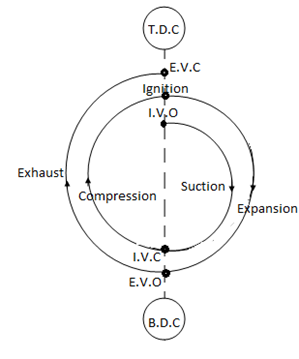
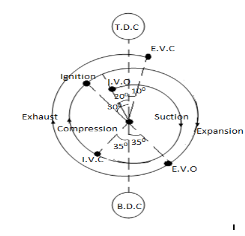
Theoretical Actual
Valve Timing Diagram for Four Stroke Diesel Engine
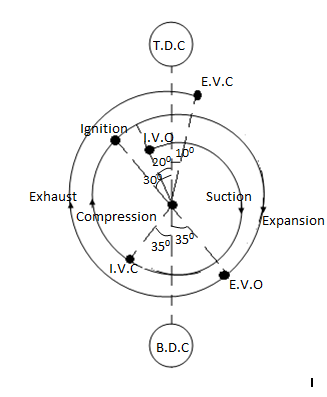
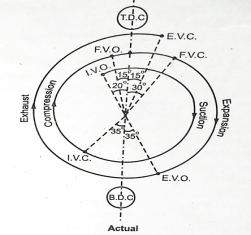
i) Crank angle sensor
A permanent magnet inductive signal generator is mounted in closed proximity to the flywheels, where it radiates a magnetic field.
As the flywheel spins and pins are rotated in the magnetic field, an alternating (AC) waveform is delivered to the ECU to indicate speed of rotation.
ii) Air flow sensor (AFS)
Air flow sensor is mounted between the air filter and the throttle body. As air flows through the sensor, it deflects a wave or flap, which wipes a potentiometers resistance track and therefore, it changes the resistance of the track to generate a variable voltage signal.
iii) Manifold absolute pressure (MAP) sensor
MAP sensor measurer the manifold vacuum or pressure and the matured value. Is converted into electrical signal by transducer. Electrical signal is return to the ECU. It changes as manifold pressure changes. ECU uses this information to measure engine load, so that, ignition timing can be advance or retarded as required.
iv) Throttle position sensor (TPD):
TPS it's provided to inform the ECU of idle position, rate of deacceleration and acceleration and wide-open throttle (WOT) condition.
Single of sensor is used by the computer to enrich the fuel Mixture during acceleration and the advance or retard the ignition timing
v) Oxygen sensor (OS)
An oxygen sensor is ceramic device place in the exhaust manifold of the engine side of catalytic converter.
The oxygen sensor returns a single to the ECU, which can almost instantaneously adjust the duration of fuel injection.
vi) Coolant temperature sensor (CTS)
CTS is usually located on the cylinder head or intake manifold.
It is used to monitor temperature of engine coolant.
Resistance of CTS is proportional to coolant temperature.
Single of CTS inform to computer, when engine is warm.
vii) Ignition timing sensor (ITS)
Here, the change is magnetic field due to movement of piston causes generation of a square pulse.
This square pulse is fed to the ECU, which activates the ignition coil and spark is produced at appropriate time.
2.8.1 Air – standard cycles
The operating cycle of an IC engine can be broken down into a sequence of separate processes:
Actual IC Engine does not operate on ideal thermodynamic cycle that are operated on open cycle.
Basic Air Standard/Ideal Cycles:
PV = m*R*T
2.8.2 Fuel air cycles and actual cycle
Fuel Air Cycles
Assumptions in fuel – air cycles
Actual Cycle
Effect of Variables on engine performance.
a) Compression Ratio
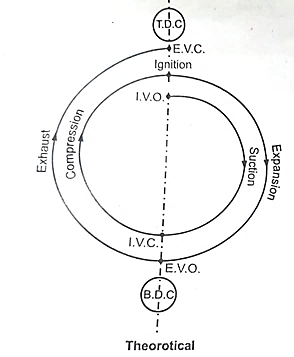
b) Fuel air Ratio: On efficiency
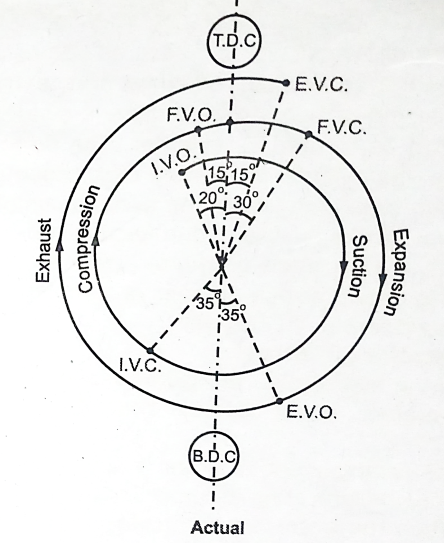
c) Fuel air ratio: On maximum power
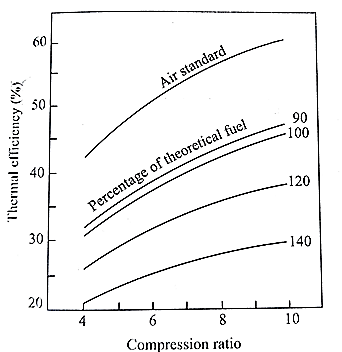
d) Fuel air Ratio: On maximum temperature
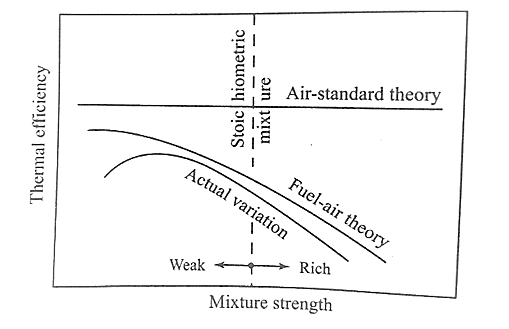
e) Fuel air ratio: Maximum pressure
f) Fuel air Ratio: On exhaust Temperature
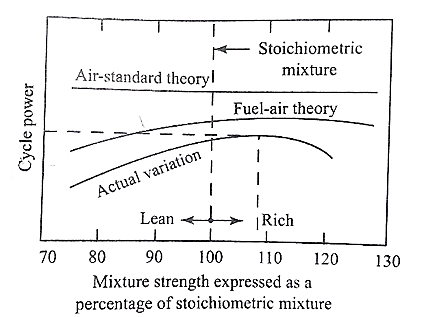
g) Fuel Air Ratio: On mean effective pressure.
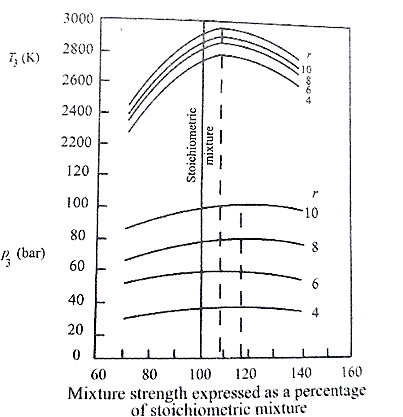
Losses in Actual Cycles:
A) Time Losses:
B) Heat Losses:
C) Exhaust Blow down losses:
D) Pumping Losses:
E) Rubbing friction losses:
Sr No | Air Standard Cycle | Fuel Air Cycle | Actual Cycle |
1 | Working substance is pure air | Working substance is mixture of fuel & air | Working substance is mixture of fuel & air |
2 | Heat is added by heat reservoirs. | Heat is added due to combustion of fuel & air | Heat is added due to combustion of fuel & air |
3 | Specific heat of gases does not change with temperature. | Specific heat of gases changes with temperature | Specific heat of gases changes with temperature |
4 | There is no change in chemical composition. | There is change in chemical composition. | There is change in chemical composition.
|
5 | The heat is supplied at constant volume in case of Otto cycle | Burning of fuel & air takes place at constant volume | Burning of fuel & air is not at constant volume |
6 | Compression & expansion processes are isentropic | Processes are not adiabatic. | Heat losses are considered. |
7. | Valves open & close instantaneously | There is time lag in opening & closing valve | There is time log in opening & closing valve. |
8 | Suction & exhaust stroke are eliminated. | Suction & exhaust stroke are at atmospheric pressure | Suction is at below atmospheric pressure & exhaust is at above atmospheric pressure |
9 | Friction is neglected. | Friction is neglected. | Friction is considered. |
Reference:
1) V. Ganesan: Internal Combustion Engines, Tata McGraw-Hill
2) M.L. Mathur and R.P. Sharma: A course in Internal combustion engines, Dhanpat Rai
3) H.N. Gupta, Fundamentals of Internal Combustion Engines, PHI Learning Pvt. Ltd.